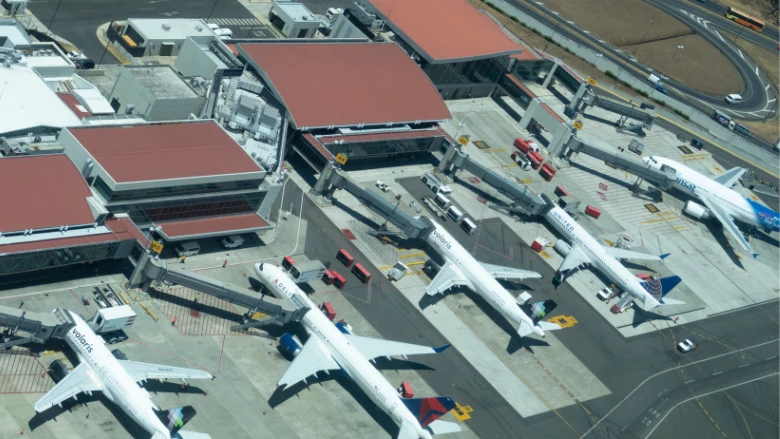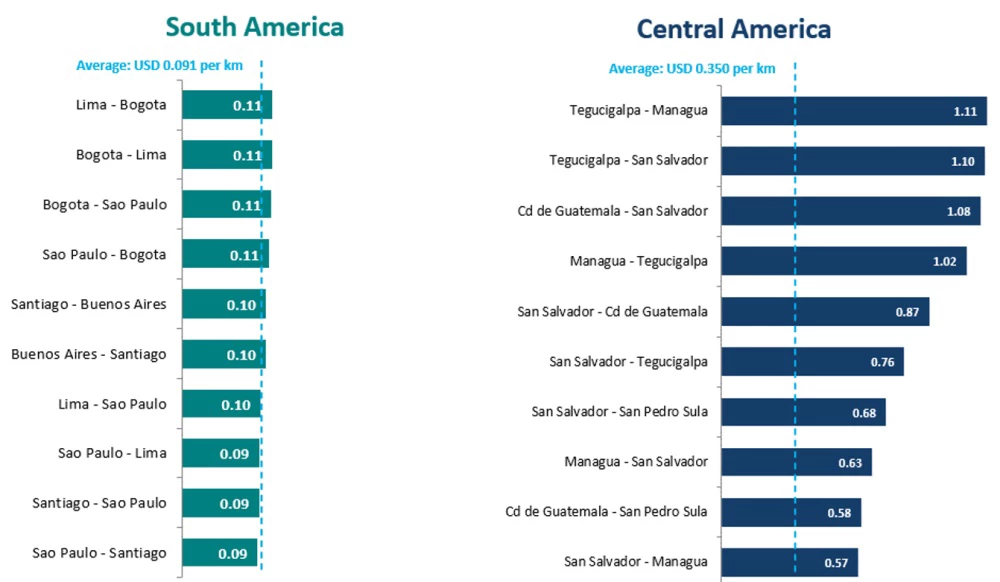 Aerial view of San Jose airport in Costa Rica. Photo: Adobe Stock.
Aerial view of San Jose airport in Costa Rica. Photo: Adobe Stock.
If you plan to fly from Bogotá to Quito, expect to pay on average around USD 200 for the 1 hour, 40-minute flight. Longer flights within Brazil, Mexico or Colombia can be even cheaper, on average. Travelers within Central America aren’t so lucky. In March 2024, a typical one-hour flight from Costa Rica to El Salvador costs between USD 500 and USD 800. Hence, by harmonizing air transport policies, Central American countries can reduce regional travel costs, making it more affordable and enhancing regional integration.
To contribute to this agenda, a World Bank study points out that tickets for flights between destinations in Central America are up to three times as expensive as similar routes in South America, pricing out the bulk of population of the market for regional air travel. This is not just an inconvenience for people seeking to visit friends or relatives. It also prevents small and medium-sized enterprises from fully reaping the benefits of regional integration through trade and undermines regional tourism.
Why is air travel so expensive in Central America?
The World Bank study suggests that limited competition, along with the high rates of airport fees imposed on regional tickets (referred to as “fees” hereafter) contribute to the problem. Central American countries impose fees for intraregional travel like those applied to long-distance travel from overseas, as opposed to those they apply to domestic flights, which are very low. They add as much as USD 120 to the price of a round-trip ticket, limiting the entry or expansion of all types of carriers, including low-cost. Additionally, they hinder the establishment of new intra-Central American routes. In Asia, Europe and South America, low-cost carriers have flourished by offering no-frills service to large numbers of passengers, pressing all carriers to follow suit. Reducing fees imposed on Central American tickets could- intensify competition and, thus, reduce the cost of intraregional travel.
The study assesses that low-cost carriers could transform the Central American air travel market by providing round-trip fares between any two points in the region to as little as USD 74, excluding fees. If all fees applied for these tickets were to fall from USD 120 to USD 40, that would entail cutting typical round-trip travel costs within Central America to as little as USD114 (plus value added taxes, when appropriate) from up to USD 880. Lower costs, in turn, could potentially stimulate business activity and lead to job creation in regionally oriented manufacturing and services sectors, including the significant tourism and hospitality industries.
Chart: The cost of intraregional air travel in Central America is substantially higher than in South America.
(Average airfares on selected regional international routes, USD per kilometer)

Source: World Bank, based on Official Airline Guide data 2019
Cooperative efforts
Over the last two years, the World Bank has been working closely with the Central American governments to encourage cooperation in reducing fees imposed on tickets for flights within the region, including Panama, Belize, and the Dominican Republic. Fees imposed on tickets from flights originating from outside the region will not be changed, as these represent the bulk of the revenue that airports and other agencies receive and are needed to cover the costs of services provided to travelers (duty-free sales and services to passengers are the other important source of revenue for airports, which will likely increase as the volume of intraregional travels increases).
In 2023, Panama took a step in this direction by lowering the departure fee to USD 26 from USD 37 at the Panama-Pacífico Airport, which reopened in recent years to operate low-cost flights. Airport fees for regional travel at the main Tocumen airport, however, are still pending to be lowered from about USD 55.
Costa Rica has followed suit by introducing a bill in the Legislative Assembly early in March calling for reducing ticket fees for intra-regional flights to less than USD 20 from a base of almost USD 60, as long as other countries in the region lower their fees as well, and airlines do not charge more than USD 80 per round trip, excluding fees. This scheme is commendable as it would ensure that consumers rather than airlines benefit from the fee cut. This initiative has the support of Costa Rica’s main five major political parties and the eight major Costa Rican private-sector associations trading with Central American countries and the Dominican Republic.
A member of the Costa Rican parliament said that the goal is for round-trip tickets, including fees, not to exceed USD 126. This would be the equivalent of a Central American bullet train, allowing transfers of one hour or less within the region.
In a meeting convened by the World Bank in Guatemala in November 2022, representatives of all Central American governments expressed their support for the initiative. Many of them were waiting for Costa Rica to make the first move. The next step is to support other governments in the push for this critical pro-integration reform in El Salvador, Guatemala, Honduras, Nicaragua, Panama, Belize, and the Dominican Republic.



Join the Conversation